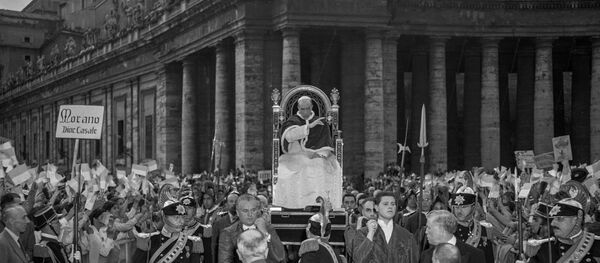In 1938, right after the Nazi annexation of Austria, 37-year-old Dr. Fritz Finaly and his wife, Anna, 28, both Jews, fled Austria, attempting to reach South America. They failed and took refuge in a village near Grenoble, France. After the puppet state of Vichy was created, it was impossible to officially continue his medical practice; however, the couple managed to survive. In 1941, Anna gave birth to their first child, Robert and, in 1942, a second son, Gerard, was born. Despite the anti-Semitic campaign launched by the government of Marshal Philippe Pétain, under Nazi pressure, the couple circumcised both children, in accordance their religion.
This story could be one of the many stories of Jewish families fleeing the Nazis. However, it reverberated in France in the early 1950s and appeared in a new light after secret Vatican archives were opened on 24 March 2019; documents from the papacy of Pius XII.
In February 1945, when France was liberated, Fritz’s sister, Margherita Finaly (who was hiding in New Zealand during those years), sought to take her nephews to their new homeland.
Margherita wrote to Brun, thanking her and asking for help in organizing Robert and Gerald’s trip. Brun was evasive in her response to Margherita’s proposal to remand the two children (at that time, they were four and three years old); she also said that the local judge had appointed her the boys’ guardian. Margarita didn’t give up and, together with her two sisters, one of whom lived in Israel and another in New Zealand, and her sister-in-law Auguste (the wife of her brother Richard, captured and killed by the Nazis in Vienna), wrote to the mayor of Grenoble. There was no answer, and Auguste, who lived in the UK, came to Grenoble to meet Brun. However, Brun refused to cooperate, showing hostility and saying she would never give the children back.
Then the real drama began, which can be traced, thanks to the Vatican archives. With the consent of the local bishop, Brun baptized the children, despite the fact that she knew of their Jewish origin, and that they would become “property” of the Roman Church and could never return to Judaism, having now become Catholics.
The Finaly family went to the French court, which ruled in July 1952 that Brun must hand the children over to their parents’ relatives. In response, the Notre Dame de Zion nuns hid the children, likely on the advice of Cardinal Gerlier, Archbishop of Lyon. In November 1952, the French court issued its official order, but the nuns addressed the Court of Appeal to review the ruling.
Soon the French press began to cover the story, and Cardinal Gerlier addressed the Vatican for instructions. The Congregation of the Roman Curia (now known as the Congregation for the Doctrine of the Faith) suggested waiting for the Court of Appeal’s ruling and, under any circumstances, in case of an unfavorable decision, “offering Ms. Brun to continue fighting, appeal to the Supreme Court of Cassation and use all legal means for the maximum possible suspension of any unfavorable ruling.”
The matter, brought to the public, was becoming uncomfortable for high-ranking Catholic Church officials. The Vatican, through the French embassy in Rome and the papal nuncio in Paris, sought an agreement to hand the boys over to their relatives, provided that “appropriate precautions would be taken so that they (the children) could not become Jews again.” Having been instructed by the Pope to monitor the matter, Cardinal Montini (later Pope Paul VI) wrote an encrypted telegram to the nuncio in Paris, saying “It’s good that there’s not a word about the Holy Chancellery (as the agreement’s initiator).” In other words, the Vatican had initially supported hiding the boys, but later shifted the responsibility to local church authorities.
Despite arrests and French court rulings, the boys were transported to a monastery in Spain and again hidden. In the meantime, Cardinal Montini, in a bid to win public approval, sent a draft article to the Vatican nuncio in Switzerland to appear in a local newspaper. The article, found in the Vatican archives, said that both boys considered themselves “refugees” and were claiming the right to asylum in Spain. It was April 1953, the boys were twelve and eleven years old.
Three months later, it was known that the boys were somewhere in Spain. French, Spanish and Israeli diplomacy entered the matter, resulting in the Spanish clergy officially announcing that “the boys would be hidden until there was a formal order from Rome.”
However, global pressure rose and the Vatican began to fear the negative impact to the Holy See’s image. Then L'Osservatore Romano published an article saying that, according to the French episcopate’s decision, the Finaly family should not be allowed to take the boys to Israel to make them Jews again. “These two boys… said they want to remain Catholics… profess and practice Catholicism.” However, public opinion in France was so strong that the Vatican was forced to return the two boys home. On 25 July, they finally arrived at the Tel Aviv airport.
When the boys grew into adulthood, Gerard became an Israeli army officer, and later worked as an engineer. Robert became a physician, like his father.
In defence of the Catholic cardinal, Montini, one might recall that, at the Second Vatican Council, as Pope Paul VI, he spoke about renewing the Church, and in 1965 published his Nostra Aetate*, which had been drafted by his predecessor, John XXIII, and titled “Decree on the Jews,” arguing that the Jewish religion and Jews, as well as Muslims, must be treated with full respect.
In August, Pulitzer Prize winner David Kertzer wrote about this subject in The Atlantic, noting also that each year, only 1,200 researchers from 60 countries are permitted access to Vatican archives.
*Nostra Aetate (Latin: “In our time”) is the declaration of the Second Vatican Council on the relation of the Church with non-Christian religions.
by Mario Sommossa





